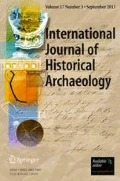Abstract
Excavations for the Abraham Lincoln Presidential Library and Museum in Springfield, Illinois, were conducted in the 2000s by Fever River Research to comply with federal Sect. 106 laws. The research yielded an extensive assemblage of domestic and commercial archaeological features. This case study focuses on Features 11 and 35 in the East Parking excavation block that yielded five bottles of Mrs. Winslow’s Soothing Syrup. Advertisements for the syrup showcased a radiant mother and her children and this imagery plays into nineteenth-century ideas concerning domesticity and motherhood; therefore, I consider the presence of multiple bottles of syrup recovered from a temporally well-defined stratigraphic range to explore the politics of gender, consumer choices, and advertising.





Similar content being viewed by others
References
Anderson, A. (2012). Snake Oil, Hustlers, and Hambones: The American Medicine Show. McFarland, Jefferson, NC.
Bair, J. (2009). Frontiers of Commodity Chain Research. Stanford University Press, Stanford, CA.
Berman, A. (1980). The eclectic "concentrations" and American pharmacy (1847-1861). Pharmacy in History 22(3): 91-103.
Brown, F. M. (2015). "Good for What Ailed You" in Springfield, Illinois: Embossed Pharmaceutical Bottles Used by Springfield Druggists from the Civil War Era to the Early Twentieth Century. Illinois State Archaeological Survey Press, Champaign.
Christensen, K. (2013). Troubling the domestic sphere: women reformers and the changing place of the home in the United States, 1854–1939. In Spencer-Wood, S. (ed.), Historical and Archaeological Perspectives on Gender Transformations: From Private to Public. Springer, New York, pp. 63–83.
Daily Illinois State Journal. (1858). August 29. Bailhache and Baker, Springfield.
Daily Illinois State Journal. (1859a). September 19. Bailhache and Baker, Springfield.
Daily Illinois State Journal. (1859b). November 1. Bailhache and Baker, Springfield.
Daily Illinois State Journal. (1859c). November 7. Bailhache and Baker, Springfield.
Daily Illinois State Journal. (1860a). February 2. Bailhache and Baker, Springfield.
Daily Illinois State Journal. (1860b). August 6. Bailhache and Baker, Springfield.
Daily Illinois State Journal. (1860c). October 16. Bailhache and Baker, Springfield.
Daily State Register. (1859a). November 3. Bailhache and Baker, Springfield.
Del Rio, R. (2019). The mass transformation of retail pharmacy and the development of a modern illicit narcotics market. Paper presented at the 44th International Congress for the History of Pharmacy, Washington, DC.
Fennell, C. (2017). Broken Chains and Subverted Plans: Ethnicity, Race, and Commodities. University of Florida Press, Gainesville.
Fike, R. E. (1987). The Bottle Book: A Comprehensive Guide to Historic, Embossed Medicine Bottles. Blackburn, Caldwell, NJ.
Flannery, M. A. (1998). John Uri Lloyd: The Great American Eclectic. Southern Illinois University Press, Carbondale.
Flannery, M. A. (2017). Civil War Pharmacy: A History. Southern Illinois University Press, Carbondale.
Graham, K. (2005). The archaeological potential of medicinal advertisements. Australasian Historical Archaeology 23: 47-53.
Heath, B. J. (2017). An historical archaeology of consumerism: re-centering objects, re-engaging with data. In Heath, B. J., Breen, E. E., and Lee, L. A. (eds.), Material Worlds: Archaeology, Consumption, and the Road to Modernity. Routledge, London, pp. 1-8.
Heath, B. J., Breen, E. E., and Lee, L. A. (eds.) (2017). Material Worlds: Archaeology, Consumption, and the Road to Modernity. Routledge, London.
Heffner, S. and 莎拉 · 贺弗那. (2015). Exploring health-care practices of Chinese railroad workers in North America / 试论北美中国铁路工人的医疗实践. Historical Archaeology 49(1): 134-147.
Hoberman, R. (2004). Constructing the turn-of-the-century shopper: narratives about purchased objects in the "Strand Magazine," 1891-1910. Victorian Periodicals Review 37: 1-17.
Hodgson, B. (2001). In the Arms of Morpheus: The Tragic History of Morphine, Laudanum and Patent Medicines. Firefly, Richmond Hill, ON
Janik, E. (2015). Marketplace of the Marvelous: The Strange Origins of Modern Medicine. Beacon, Boston.
Laird, P. W. (2020). Advertising Progress: American Business and the Rise of Consumer Marketing. Johns Hopkins University Press, Baltimore, MD.
Larsen, E. L. (1994). A boardinghouse madonna: beyond the aesthetics of a portrait created through medicine bottles. Historical Archaeology 28(4): 68-79.
Lears, T. J. J. (2009). Fables of Abundance: A Cultural History of Advertising in America. Basic, New York.
Linn, M. B. (2008). From Typhus to Tuberculosis and Fractures in between: A Visceral Historical Archaeology of Irish Immigrant Life in New York City, 1845–1870. Doctoral dissertation, Columbia University, New York.
Linn, M. B. (2010). Elixir of Emigration: Soda Water and the Making of Irish Americans in Nineteenth-Century New York City. Historical Archaeology 44(4): 69–109.
Lynch, K. D. (2005). Advertising motherhood: image, ideology, and consumption. Berkley Journal of Sociology 49: 32-57.
Majewski, T. and Schiffer, M. (2009). Beyond consumption: towards an archaeology of consumerism. In Majewski, T. and Gaimster, D. (eds.), International Handbook of Historical Archaeology. Springer, New York, pp.191-207.
Mansberger, F. (2009). Archaeological Investigations of the East Half Parking Lot Area, Abraham Lincoln Presidential Library and Museum, Springfield, Illinois. Fever River Research, Springfield.
Marcellus, J. (2008). Nervous women and noble savages: the romanticized "other" in nineteenth-century US patent medicine advertising. Journal of Popular Culture 41(5): 784-808.
Mullins, P. R. (2011). The Archaeology of Consumer Culture. University Press of Florida, Gainesville.
Orser, C. E. (2009). World-Systems Theory, Networks, and Modern-World Archaeology. In Majewski, T. and Gaimster, D. (eds.), International Handbook of Historical Archaeology. Springer, New York, pp. 253-268.
Rotman, D. L. (2006). Separate spheres? beyond the dichotomies of domesticity. Current Anthropology 47(4): 666-674.
Rotman, D. L. (2013). Domestic production for public markets: the arts and crafts movement in Deerfield, Massachusetts, c. 1850–c. 1911. In Spencer-Wood, S. (ed.), Historical and Archaeological Perspectives on Gender Transformations. Springer, New York, pp. 45-62.
Smith, M. L. (2007). Inconspicuous consumption: non-display goods and identity formation. Journal of Archaeological Method and Theory 14(4): 412-438.
Spencer-Wood, S. M. (ed.) (1987). Consumer Choice in Historical Archaeology. Springer, New York.
Spencer-Wood, S. M. (1999). The world their household: changing meanings of the domestic sphere in the nineteenth century. In Allison, P. M. (ed.), The Archaeology of Household Activities. Routledge, London, pp. 162-189.
Springfield City Directory. (1860). Springfield, Illinois, City Directory. R. L. Polk, Sangamon Valley Collection, Lincoln Library, Springfield, IL.
Wall, D. d. (1991). Sacred dinners and secular teas: constructing domesticity in mid-19th-century New York. Historical Archaeology 25(4): 69-81.
Wall, D. d. (1994). The Archaeology of Gender: Separating the Spheres in Urban America. Springer, New York.
Young, J. H. (1961). The Toadstool Millionaires: A Social History of Patent Medicines in America before Federal Legislation. Princeton University Press, Princeton, NJ.
Acknowledgements
The author would like to thank Floyd Mansberger and Fever River Research for generously allowing the use of the data on Springfield excavations. The detailed data and city history allowed for a close examination of the data and its meaning that would not have been possible without such meticulous record keeping.
Author information
Authors and Affiliations
Corresponding author
Ethics declarations
Competing Interests.
The authors have no competing interests to declare that are relevant to the content of this article.
Additional information
Publisher's Note
Springer Nature remains neutral with regard to jurisdictional claims in published maps and institutional affiliations.
Rights and permissions
About this article
Cite this article
Verstraete, E. Soothing the Self: Medicine Advertisement and the Cult of Domesticity in Nineteenth-Century Springfield, Illinois. Int J Histor Archaeol 27, 143–157 (2023). https://doi.org/10.1007/s10761-021-00644-1
Accepted:
Published:
Issue Date:
DOI: https://doi.org/10.1007/s10761-021-00644-1




